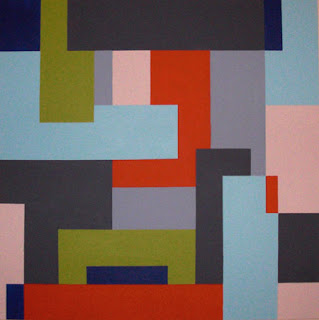 "Pulse"
"Pulse"36"x36"
Acrylic on Canvas


 "Metronome"
"Metronome"36"x36"
Acrylic on Canvas

Last month I gave in to the urge to explore painting without a very charged medium -- "wax" (encaustic/beeswax-pigments-resin). Things in the studio were very slow at first but eventually picked up like I predicted. But, the waiting is sometimes unnerving after a period of rapidly churning out painting after painting.
In the pursuit of searching for the true 'driver' in my work, I interrupted the comfortable rhythm of my studio practice. The dreaded but necessary "painter's block" came as a result of eliminating the process of managing hot palettes, pigments, resin, heat guns, torches, and safety issues. This large self-imposed gap forced me to adapt and go deeper. I was questioning the "why of wax"?
Why would I want to change materials after years of responding to it and dedicating the work to this challenging and rewarding medium? It seems the work is asking me to look for something that I am missing. In my self-investigation of the work of the last 5 years, there is something very interesting to me about it. The grid and hard edge was always the starting point for my work. But possibly due to my lack of exposure to like-minded painters, or responding directly to the medium itself, I unconsciously buried this in my paintings for years -- excavating layers and layers of wax trying to uncover the grid. Here, the response may have been to the medium instead of the medium providing the visual language? This is why I refer to Encaustic as a 'charged' medium. In the past 6 months the geometric abstraction and hard edge is more and more visible, the palette more complex as well as the engagement with a more complex composition.
These two new paintings, "Metronome" and "Pulse" came after a few weeks of playing around with another kind of paint, canvas over panel, color, and format. The simplification in this new process with minimal tools and more economical materials is freeing. This thought takes me back to the AbEx painters and their following a less conventional and more economical means to making art -- Pollack pouring house paints, and Jasper Johns' use of wax and newspapers.
Your familiar materials and comfort zone can limit your voice--affecting your work as a result. So, when new materials appear, or in my case, simplified, it translates to new possibilities when the work demands something -- knocking hard. Letting go of bits of familiar materials and experimenting at mid-point really undermines studio rituals including your judgements of where you think you should be.
As a painter, responding to the work is very necessary to my process even when it asks for a very uncomfortable change. And, when you can, it takes you hopefully where you need to be. The uncertainty and unpredictability of making art forces you to risk and want to believe it broadens your ability to make and find what you're looking for. I'm hanging with this and ready to start on a new painting tomorrow.
No comments:
Post a Comment